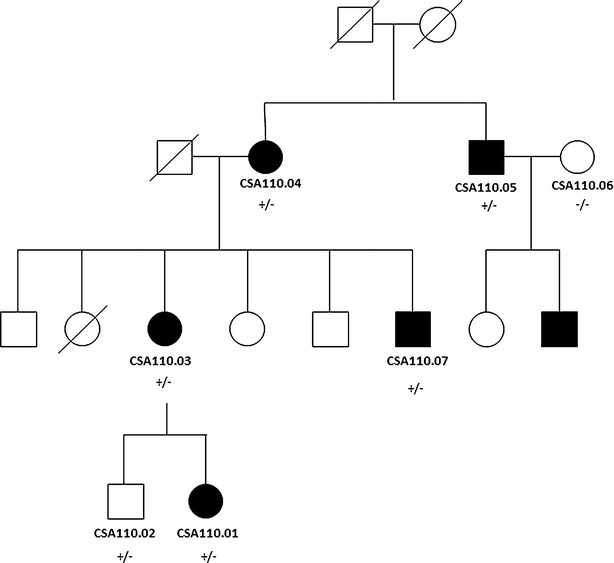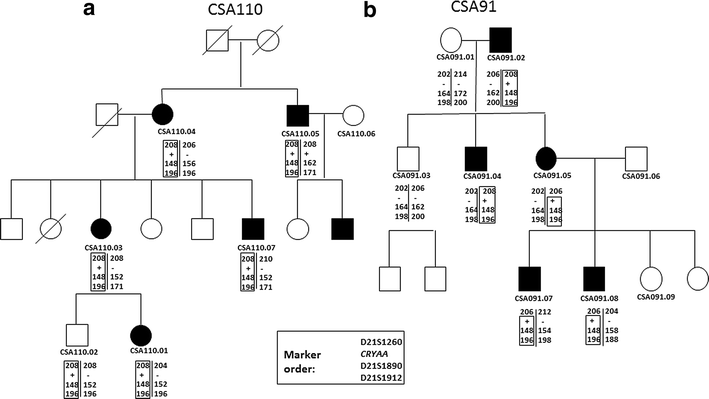Recurrent mutation in the crystallin alpha A gene associated with inherited paediatric cataract
- PMID: 26867756
- PMCID: PMC4750205
- DOI: 10.1186/s13104-016-1890-0
Recurrent mutation in the crystallin alpha A gene associated with inherited paediatric cataract
Abstract
Background: Cataract is a major cause of childhood blindness worldwide. The purpose of this study was to determine the genetic cause of paediatric cataract in a South Australian family with a bilateral lamellar paediatric cataract displaying variable phenotypes.
Case presentation: Fifty-one genes implicated in congenital cataract in human or mouse were sequenced in an affected individual from an Australian (Caucasian) family using a custom Ampliseq library on the Ion Torrent Personal Genome Machine. Reads were mapped against the human genome (hg19) and variants called with the Torrent Suite software. Variants were annotated to dbSNP 137 using Ion Reporter (IR 1.6.2) and were prioritised for validation if they were novel or rare and were predicted to be protein changing. We identified a previously reported oligomerization disrupting mutation, c.62G > A (p.R21Q), in the Crystallin alpha A (CRYAA) gene segregating in this three generation family. No other novel or rare coding mutations were detected in the known cataract genes sequenced. Microsatellite markers were used to compare the haplotypes between the family reported here and a previously published family with the same segregating mutation. Haplotype analysis indicated a potential common ancestry between the two South Australian families with this mutation. The work strengthens the genotype-phenotype correlations between this functional mutation in the crystallin alpha A (CRYAA) gene and paediatric cataract.
Conclusion: The p.R21Q mutation is the most likely cause of paediatric cataract in this family. The recurrence of this mutation in paediatric cataract families is likely due to a familial relationship.
Figures





Similar articles
-
Identification of a novel oligomerization disrupting mutation in CRYΑA associated with congenital cataract in a South Australian family.Hum Mutat. 2013 Mar;34(3):435-8. doi: 10.1002/humu.22260. Epub 2013 Jan 17. Hum Mutat. 2013. PMID: 23255486
-
Crystallin gene mutations in Indian families with inherited pediatric cataract.Mol Vis. 2008 Jun 16;14:1157-70. Mol Vis. 2008. PMID: 18587492 Free PMC article.
-
Novel missense mutation in the bZIP transcription factor, MAF, associated with congenital cataract, developmental delay, seizures and hearing loss (Aymé-Gripp syndrome).BMC Med Genet. 2017 May 8;18(1):52. doi: 10.1186/s12881-017-0414-7. BMC Med Genet. 2017. PMID: 28482824 Free PMC article.
-
Alpha-crystallin.Exp Eye Res. 2003 Feb;76(2):145-53. doi: 10.1016/s0014-4835(02)00278-6. Exp Eye Res. 2003. PMID: 12565801 Review.
-
Genetic landscape of isolated pediatric cataracts: extreme heterogeneity and variable inheritance patterns within genes.Hum Genet. 2019 Sep;138(8-9):847-863. doi: 10.1007/s00439-018-1932-x. Epub 2018 Sep 5. Hum Genet. 2019. PMID: 30187164 Free PMC article. Review.
Cited by
-
A mutated CRYGD associated with congenital coralliform cataracts in two Chinese pedigrees.Int J Ophthalmol. 2021 Jun 18;14(6):800-804. doi: 10.18240/ijo.2021.06.03. eCollection 2021. Int J Ophthalmol. 2021. PMID: 34150533 Free PMC article.
-
Transcriptional profiling of single fiber cells in a transgenic paradigm of an inherited childhood cataract reveals absence of molecular heterogeneity.J Biol Chem. 2019 Sep 13;294(37):13530-13544. doi: 10.1074/jbc.RA119.008853. Epub 2019 Jun 26. J Biol Chem. 2019. PMID: 31243103 Free PMC article.
-
αA-crystallin-derived minichaperone stabilizes αAG98R-crystallin by affecting its zeta potential.Mol Vis. 2018 Apr 11;24:297-304. eCollection 2018. Mol Vis. 2018. PMID: 29706763 Free PMC article.
-
Inherited Congenital Cataract: A Guide to Suspect the Genetic Etiology in the Cataract Genesis.Mol Syndromol. 2017 Mar;8(2):58-78. doi: 10.1159/000455752. Epub 2017 Feb 7. Mol Syndromol. 2017. PMID: 28611546 Free PMC article. Review.
-
Two novel mutations identified in ADCC families impair crystallin protein distribution and induce apoptosis in human lens epithelial cells.Sci Rep. 2017 Dec 19;7(1):17848. doi: 10.1038/s41598-017-18222-z. Sci Rep. 2017. PMID: 29259299 Free PMC article.
References
-
- Rahi JS, Dezateux C. Measuring and interpreting the incidence of congenital ocular anomalies: lessons from a national study of congenital cataract in the UK. Invest Ophthalmol Vis Sci. 2001;42:1444–1448. - PubMed
Publication types
MeSH terms
Substances
LinkOut - more resources
Full Text Sources
Other Literature Sources
Medical
Molecular Biology Databases

